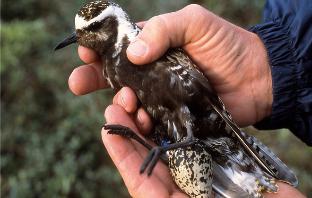Published in the Ocean Watch column, Honolulu Star-Advertiser © Susan Scott
August 18, 2014
A couple weeks ago, I had one of those days when my brain felt like an iPod shuffle stuck on fast forward. Deadlines, chores, errands, family and a hundred other things raced through my head until I finally gave up trying to work. Turning off the computer, I went for a walk in a nearby park.
 Enormous eggs: Each one is about a quarter of the length of a female kolea.
Enormous eggs: Each one is about a quarter of the length of a female kolea.
Courtesy Wally Johnson
It was a hot, still day and I soon stopped to sit in the shade of a monkeypod tree. And at that exact moment, a Pacific golden plover dropped from the sky and landed in the grass not 20 feet away.
I had just witnessed the arrival of my first kolea of the season.
She was not, however, the first plover to return to Oahu this summer. Nor am I the first person to look up to see a plover descend from the heavens.
Earlier this month a fellow plover lover emailed that her kolea arrived in her yard July 31.
“It landed just as I looked outside, about 6 p.m.” Cindy wrote. “Pretty early this year?”
Yes, July 31 is a bit early, but not extraordinary. The early birds are usually females needing a long tropical vacation from their summer job of laying their enormous eggs.
Each kolea egg is about a quarter the length of the bird and weighs just under an ounce. That may not sound very heavy (an AA battery weighs about an ounce), but it means that a freshly laid clutch of four eggs weighs about the same as the fat-free female, about 3.5 ounces.
She’s bone thin, of course, having used the fat she gained in Hawaii first to fly 3,000 nonstop miles to Alaska, and soon after to develop her eggs. Because the female lays each egg about a day and a half apart, it takes six to seven days to produce a typical nest of four.
But that’s not always the end of her procreative push. If an owl, hawk or other predator eats a plover’s eggs, or a caribou breaks them while tramping through a colony, these formidable females, keeping the same nest and mate, start over. The first egg of the replacement batch appears, amazingly, within a week of the loss.
Lost clutches are common. At one study site from 1993 to 2002, 50 to 100 percent of kolea eggs were crushed or eaten.
No wonder that when their chicks get near fledging, the worn-out moms beat it back to Hawaii, leaving dad and the kids to follow.
I watched my first kolea of the season for 20 minutes, thinking about her miles flown, eggs laid and chicks raised, as well as how these busy bundles of feathers brighten the days of so many people in Hawaii.
Being one of those people, I walked home at peace.